Annual Report, July 1, 1995 – June 30, 1996

The Commission on Preservation and Access was established in 1986 to foster and support collaboration among libraries and allied organizations in order to ensure the preservation of the published and documentary record in all formats and to provide enhanced access to scholarly information.
The Council on Library Resources is a private operating foundation established in 1956 to look toward the future on behalf of libraries, to address problems experienced by libraries in the aggregate, and to identify innovative solutions. It promotes research, organizes conferences, issues publications, and manages collaborative projects to bring about significant changes in its areas of interest.
Following a year of affiliation, the Boards of the Commission and Council confirmed plans for an administrative merger in April and May of 1996. Together, the two organizations work to provide equitable and enduring access to information.
The Commission on Preservation and Access
The Council on Library Resources
1400 16th Street NW, Suite 715
Washington, DC 20036-2217
USA
(202) 939-3400
(202) 939-3370
World Wide Web:
http://clir.stanford.edu/cpa/
http://clir.stanford.edu/clr.html
Additional copies are available at no cost while supplies last.
Submitted to ERIC (Educational Resources Information Center).
TABLE OF CONTENTS
Acknowledgment: Foundations and Sponsors
Introduction
Organization and Support
Digital Libraries
Economics of Information
Leadership
Preservation
The International Program
Communications and Publications
Collaborations
Appendices (Available in print version)
Publications and Reports
Grants and Contracts
Committees and Task Forces
Boards and Staff
Financial Statements
Acknowledgment
The following foundations and sponsors provide crucial support for the activities and programs
of the Commission on Preservation and Access and the Council on Library Resources.
Foundations
Carnegie Corporation of New York
The Gladys Krieble Delmas Foundation
The William and Flora Hewlett Foundation
IBM Corporation
W. K. Kellogg Foundation
The Andrew W. Mellon Foundation
H. W. Wilson Foundation
The following organizations are funding the American Council of Learned Societies and the Commission
to develop a documentary on preservation of digital information.
National Endowment for the Humanities
Alfred P. Sloan Foundation
Xerox Corporation
Sponsors – The Commission on Preservation and Access
July 1, 1995 – June 30, 1996
University of Alberta
Association of American Publishers
Boston College
Boston Public Library
Brown University
University of California, Berkeley
University of California, Davis
University of California, Los Angeles
University of California, San Diego
College of Charleston
University of Chicago
Coalition for Networked Information
University of Colorado
Columbia University
University of Connecticut
Cornell University
Dartmouth College
Duke University
Emory University
Franklin & Marshall College
HarperCollins Publishers
Harvard University
John Wiley & Sons, Inc.
Johns Hopkins University
University of Kansas
Lehigh University
Library of Congress
Macmillan Foundation
Massachusetts Institute of Technology
Miami University
University of Michigan-Ann Arbor
University of Minnesota
National Agricultural Library
National Library of Medicine
New York Public Library
New York University
North Carolina Central University
North Carolina State University
University of North Carolina, Chapel Hill
Northeastern University
Northwestern University
Ohio State University
University of Oregon
Pennsylvania State University
University of Pennsylvania
University of Pittsburgh
Princeton University
The Reader’s Digest Association, Inc.
Simon & Schuster
Southeastern Library Network, Inc.
University of Southern California
Southern Methodist University
Stanford University
State University of New York at Albany
Syracuse University
University of Tennessee
University of Texas at Austin
The Times Mirror Company
University of Toronto
Washington University
University of Washington
Wesleyan University
University of Wisconsin-Madison
Yale University
Others
LS 2000 Users Group
Introduction
![]()
he Boards of the Commission on Preservation and Access and the Council on Library Resources, in their respective meetings in May and April, voted to merge the organizations into a single entity. Consequently, this annual report combines the program activities of the two organizations into one narrative. To fulfill legal and fiscal requirements, the financial reports are included separately.
We believe that each organization’s mission is strengthened by the merger, and we have reduced operating costs in the process. Just as libraries, archives, and educational institutions are restructuring to become more efficient and effective, so are we. Thus far, the merger is informal. The conjoint Board will hold its first meeting on October 31, 1996, but the new organization is already behaving as a single organism. Program directions have been established according to the needs of our constituent communities. The staff has long since ceased thinking about the specific mission of one organization or the other. If the affiliation process moves ahead as smoothly as we expect, the formal merger will be accomplished next spring.
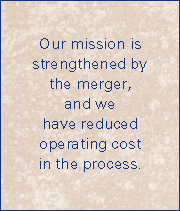
We have learned an important lesson during this period of transition: names are not terribly important until there is serious talk of changing them. At the moment, the organization is known as the Commission on Preservation and Access and the Council on Library Resources. It does not roll smoothly over the tongue, but it does acknowledge that each of the organizations has a history, a culture, and a long list of accomplishments that cannot be dismissed lightly.
The conjoint Board recognizes that names not only recall past connections, but they also reflect a sense of purpose and imply a mission. With this in mind, the Board will hold a retreat on September 8-9, 1996, to discuss the role and mission of the new organization, the scope of its programmatic activities, and a new name that reflects our future direction. We believe that the new entity should be more than a combination of two very important and respected organizations. This is the time, we are convinced, to think about the information management structures that will be required for the twenty-first century. What must be in place to assure enduring and equitable access for scholars and researchers so that all that has been learned and thought and recorded becomes raw material for new knowledge in subsequent generations? What are libraries’ and archives’ obligations to society? Can we continue to think of the public library as the ubiquitous information resource for anyone with a question? Can the investment in research libraries and archives be translated into access to resources for the general public at a reasonable cost? And in answering all of these questions comes the question we must ask of ourselves: What does a neutral, but catalytic, organization offer to the discussion?
We believe that an independent organization–one that is not confined by needs of members or restrictions of endowments–can be most useful during the transition period. Such an organization can bring thoughtful and creative individuals together to discuss information policies and their implications. It can serve as an ever-present voice for the cause of preservation. It can identify the best minds to produce reports on the issues of real substance. And, it can promote wide discussion of issues by disseminating the results of studies to individuals and organizations in positions of influence and decision-making. The small staff of the Commission and Council is not equipped to accomplish all the work that is needed, but we are committed to facilitating cooperation among the talented and creative people who will shape and transform the information agencies that serve the needs of scholarship and society.
Appreciation
The new organization and its mission are very much on my mind as I write this report, but I must also take the opportunity to acknowledge the important programmatic accomplishments of the year just completed. Everything that has been achieved is a result of the hard work and persistence of the staff of the Commission and Council, and to the loyal and dedicated service of many volunteers from research libraries, archives, public libraries, and institutions of higher education. Other organizations with related purposes have joined forces with us at various times to accomplish important goals. In particular, we thank the American Council of Learned Societies, the Association of Research Libraries, the Coalition for Networked Information, OCLC, Inc., and the Research Libraries Group for lending moral and organizational support. Stanford University Libraries has provided technical and intellectual assistance for creating an electronic presence on the World Wide Web for the Commission and the Council. To all who have lent assistance, our sincere thanks.
A special note of thanks is due to the many private foundations, corporations, institutions, and individuals who have contributed financially to our programs. The Leadership Program of the Council on Library Resources has been supported by the W. K. Kellogg Foundation. The Andrew W. Mellon Foundation has provided general support for the two organizations, and has also contributed to specific program initiatives in the areas of digital libraries, preservation and access publications, the economics of information, and the international program. The William and Flora Hewlett Foundation has underwritten technology and communications initiatives related to preservation and access. The IBM Corporation provided start-up funding for the National Digital Library Federation. The Alfred P. Sloan Foundation and the Xerox Corporation, along with the National Endowment for the Humanities, have financed a new documentary film on the preservation of digital information. The LS 2000 Users Group, when it decided its work was done, contributed its remaining assets to the Council on Library Resources for general support. Finally, some 64 universities, colleges, and publishers have contributed annually to support the work of the Commission on Preservation and Access. We are indebted to each of these contributors, and we recognize that our accomplishments are possible only because they have placed their confidence and trust in us through their grants.
–Deanna B. Marcum, President
Organization and Support
Council and Commission Affiliation
![]()
he period of July 1, 1995, through June 30, 1996, marked the first full year of affiliation between the Council on Library Resources and the Commission on Preservation and Access. The Boards of both the Commission and Council confirmed plans for an administrative merger at their respective meetings May 10 and April 23, 1996. They will hold the first conjoint meeting in fall 1996.
During this period of transition, the Commission and Council worked to develop programs that build on the strengths of each and address the most pressing needs of libraries and other information organizations as they approach the next millennium. In these deliberations, the organizations sought to encourage new alliances and partnerships, form new types of working groups to study problems and recommend alternatives for the future, engage disparate groups in discussions of their different perspectives, and develop models for institutional change.
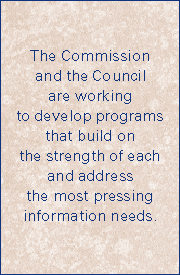
The treasurer of the Council and Commission, Linda J. Hutter, resigned effective June 30, 1996. Julia C. Blixrud, CLR Program Officer, resigned September 1,1995.
Collaborative Organizations
As described more fully later in this report, the Commission and Council spearheaded the preliminary organizational planning for the National Digital Library Federation and appointed a Policy Board and Planning Task Force for the 16-member federation. The Commission and Council also coordinated the work of two other multi-institutional efforts: The 21-member Task Force on Archiving of Digital Information (convened jointly with the Research Libraries Group) and the 20-member Preservation Science Council.
Commission on Preservation and Access Board Membership
At the annual meeting in November 1995, newly-elected members Stanley Chodorow, Provost of the University of Pennsylvania, and Elaine Sloan, Vice President for Information Services and University Librarian at Columbia University, began three-year terms. The Board acknowledged the many contributions of founding member Millicent Abell upon her retirement from the Board and completion of three terms of service.
In May, 1996, Chodorow was elected chairman to succeed Billy E. Frye, Provost of Emory University, effective at the fall 1996 meeting. Frye had served as chairman since the Commission’s founding. The Board accepted with regret the resignation of John L. Heilbron, Professor in the Graduate School, University of California, Berkeley.
Council on Library Resources Board Membership
William Hubbard, Jr. assumed chairmanship of the Board in November.
Charles Churchwell, former chairman of the Board, resigned for health reasons in April. The Board acknowledged Dr. Churchwell’s many contributions to the Council and the profession.
Grants Received
A crucial planning phase for the National Digital Library Federation received support from the IBM Corporation, which also provided technical consulting services.
The production of the film tentatively titled Into the Future was supported with grants to the American Council of Learned Societies and the Commission from the National Endowment for the Humanities, the Xerox Corporation, and the Alfred P. Sloan Foundation.
In January, The Andrew W. Mellon Foundation awarded a four-year grant for general support. The funding provides a stable operating core on which to base an array of programmatic activities. With separate grants, The Mellon Foundation supported the International Program and the Small Grants Program in the Economics of Information.
The addition of Commission sponsors throughout the year, from an initial 22 institutions to a final 64, increased the base of involvement for preservation and access activities. Sponsors included libraries, archives, universities, publishers, and other professional organizations.
On behalf of the LS 2000 Users Group, Larry Besant presented the remaining assets of that dissolving organization to the Council to further its aims and objectives.
Digital Libraries
National Digital Library Federation
![]()
he National Digital Library Federation (NDLF), organized in May 1995, became a charter organization of 16 members. Its membership includes 15 research institutions (including the Library of Congress and the National Archives) and the Commission. The goal of the NDLF is to advance coherent and enduring access to physically distributed sources of digital information supporting teaching, learning, and research.
The first phase of planning ended on June 1, 1996, with a final report from the NDLF’s Planning Task Force. The report concluded that a national digital library will be feasible only if it is founded on the principles of federation, which will ensure that the digital technologies employed are affordable and appropriate to the needs of the higher education community. Task force members established working groups to consider the key technical, financial, and organizational issues in forming a digital library and discussed how the Federation could help in its creation. The report identifies three areas in which the NDLF could play a unique and important role in building a digital library infrastructure: discovery and retrieval, rights and economic models, and archiving.
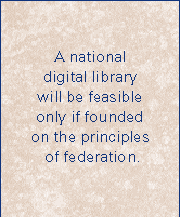
Upon reviewing the report, the NDLF’s Policy Board agreed that the structure of the Federation should be decided only after several other issues, including the collective program agenda, are settled. The directors who make up the Policy Board further concluded that institutions should contribute funds to support a program officer and research associate, travel costs of staff from participating NDLF institutions, and communications among participants and with other groups. In addition, institutions will contribute to a capital fund to be used for specific projects. The central coordinating staff will be housed at the Commission and Council and will work exclusively on NDLF projects.
In its report, the Planning Task Force stressed that the construction of a national digital library that operates as a federation must respect and accommodate decision making at each institution, while also identifying and endorsing those processes and standards that are the prerequisites for a coherent network of scholarly information resources and services. The task force concluded that much of the technology that would facilitate a federated approach to a national digital library is either already available or well advanced in development. Most of the charter members of the federation are already working on effective digital services. However, if the individual work is to contribute to a greater whole–the construction of a national digital library–it will need to be based on a set of common structures and protocols. The Planning Task Force recommended that the National Digital Library Federation identify and promulgate protocols for discovery and retrieval (including metadata), intellectual property rights and economic models, and archiving of digital information.
Task Force on Archiving of Digital Information
A second important technology project, the Task Force on the Archiving of Digital Information, culminated in a report, Preserving Digital Information, issued on June 1, 1996. The 21-member task force, composed of librarians, archivists, information technologists, and government agency and publishing firm representatives, concluded that the preservation of digital information is not simply a matter of “refreshing” data or copying it onto new media or formats, but entails a whole nexus of migration issues if the information is to remain useful.
The report’s greatest contribution may be its careful and thoughtful analysis of what is involved if an organization or individual aims to provide indefinite access to records stored in digital electronic form. The report provides, in essence, a tutorial on the issues involved in preserving the content, fixity, reference, provenance, and context of digital files. The report also examines different approaches required to preserve different types of information.
The report concludes with nine recommendations aimed at the library, archival, and higher education communities, generally. The recommendations are based on the premise that there should be a system to certify archives. These certified digital archives would have the legal right to take the necessary steps to save culturally significant digital information at risk of being inadvertently lost or intentionally destroyed.
Although the task force did not advance particular models for developing digital archives, it called upon interested stakeholders to develop collectively the standards and criteria for certification to assure that digital archives will provide secure storage and access for the long term.
By the end of the year, the major networks, OCLC and RLG, had begun to address their roles in developing digital archives, and the Association of Research Libraries’ Preservation Committee held a special meeting to discuss that association’s potential role in developing standards for certification. All of these organizations recognize that the cost of digital archiving will be great, and that shared efforts are necessary.
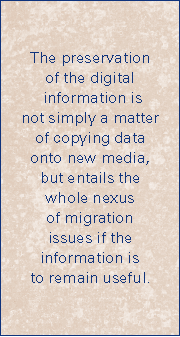
The Commission on Preservation and Access is studying the recommendations and deciding which projects it will undertake in the next year.
The Council and Commission jointly sponsored an inventory of projects that are employing digital scanning–or other electronic conversion methods–to make the content of library collections available in digital form. The inventory, a snapshot of the digital projects in various scholarly and professional disciplines, is a work-in-progress. It is intended to be the first step toward comprehending the growing variety of conversion and dissemination projects that are being planned or are under way.
Vision 2010
Vision 2010, a two-year project funded by the Carnegie Corporation to study the implications of digital technology for higher education, concluded in May 1996. In addressing this issue, the Commission recognized that the challenges to managing information resources extend well beyond the library. If digital technology is to be employed effectively, higher education institutions and their departments cannot remain independent and autonomous. Since the School of Information and Library Studies, University of Michigan, also was considering the influence of digital technology on the academy, the Commission asked the university to become its partner in carrying out the project.
The several discussions held with various groups of academic leaders during this project revealed widespread concern about current and future changes in higher education. The discussions also revealed academics’ anxiety about highly competitive commercial interests in information delivery opportunities. All of the participants readily acknowledged that the academy no longer had the luxury of conducting its business as usual. In summary, the discussions were viewed as quite illuminating and helpful. Perhaps the most important result of the project is the recognition of many university officers that there is a lack of the leadership for steering these institutions into the future.
The Commission and Council have resolved to address leadership development for the future as one of their primary program goals for the next few years. Vision 2010 has been instrumental in identifying the need and establishing many of the themes that must be incorporated into the next stage of program activity.
Digital Library Projects
In addition, the following digital library projects were funded either by the Commission or the Council during the year:
- In cooperation with OCLC, Inc., the Council initiated a project to manage and coordinate the development of a Civil War Virtual Library as a pilot project in digital archiving. Working with two repository partners–the Museum of the Confederacy and Knox College–the Council and OCLC have assembled a selection of Civil War regimental histories and veteran memoirs to be made available online to segmented audiences in order to study and measure user response and needs.
- The Commission on Preservation and Access funded a pilot project on the preservation of digital information in the Yale Social Science Data Archive, one of the oldest university library collections of numeric information in digital form. The project will contribute to the development of best practices in areas of concern identified by the Task Force on Archiving of Digital Information. The project seeks to identify the best means of migrating data from a significant collection of public opinion polls. In addition, the codebooks, which are in paper form and are rapidly deteriorating, will be converted to digital form in order to enable continued discovery, retrieval, and use of the numeric data files.
- The Commission and the Council jointly supported a proposal from Yale University to create an online tool that will assist academic research libraries in negotiating electronic licensing agreements. The tool will be created for use on the World Wide Web and will be widely accessible to any organization through a standard browser.
Economics of Information
![]()
s libraries move into the new age of electronic communication, data on the costs of both old and new systems of information management and delivery are necessary for planning and budgeting. The Council’s Economics of Information program completed several projects during the past year and began a two-year effort, funded by The Andrew W. Mellon Foundation, to provide small grants for projects that provide useful information on the costs of traditional and electronic library services.
Mellon Small Grant Program in the Economics of Information
The Council’s Small Grant Program in the Economics of Information, launched in January 1996, is intended to stimulate research, encourage the collection of badly needed data, and promote economic analysis of library operations and services. Guided by a list of priority subjects developed by the Council’s Economics of Information Advisory Committee, a working group comprising academic librarians, economists, and information specialists, the Council hopes to encourage research in several areas. These include studies of cost and pricing issues related to the transmission of digital information, cost-benefit analysis of commercial documentary delivery services, life-cycle costing models for print and electronic media, and analysis of the scholarly information market.
The Economics Advisory Committee reviewed the first round of proposals submitted in April and awarded grants to the following projects:

-
- University of California, Berkeley, Library, Berkeley, CA, for a planning project to study “Performance Measures for Research Library Collection and Information Services.” This pilot project will develop a set of qualitative and quantitative measures for evaluating the performance and costs of research library collections and related information services.
- Association of Research Libraries (ARL), Washington, DC, for a project to study “The Character and Nature of Research Library Investment in Electronic Resources.” This study will examine data on expenditures for electronic resources in research libraries by using data that ARL has been collecting for several years but that suffers from variations in reporting that in the past have made analysis and comparison difficult. The project will refine definitions and develop new categories to facilitate use of the existing database.
- Johns Hopkins University, Milton S. Eisenhower Library, Baltimore, MD, for a project to provide “Comprehensive Access to Print Materials (CAPM).” The grant will support a continuing project at Johns Hopkins University to develop a system that permits scholars and students to gain access to print materials stored off-site by using a combination of new technologies, including robotics, digital cameras, scanners, and high-speed telecommunications. The project will investigate the costs of these various retrieval systems.
Each of these projects, when finished, will contribute to a broader understanding of the economics of information and how actual costs can be measured and analyzed. From the Council’s perspective, these projects represent building blocks that will not only solve particular problems or answer specific questions at each of the sponsoring institutions; they will also provide valuable information and data that can be used by a variety of libraries and information agencies.
HighWire Press User Survey
The Council has been exploring the emergence of scholarly journal electronic publishing and the cost implications that this means of dissemination will have on libraries in the future. To learn more about user reactions to electronic scientific journals, the Council joined forces with the HighWire Press of the Stanford University Libraries and commissioned the first phase of a two-phase project that will create an in-depth profile of users and their attitudes. Ultimately, the study will provide the means for comparing user responses to free online information and fee-for-service information. The survey, which will be completed in December 1996, is being conducted among users of two scientific journals, Science and The Journal of Biological Chemistry, both of which are made available online by the HighWire Press. The HighWire staff already conducted pre-testing of survey questions, refined the survey to focus on an e-mail and telephone solicitation of information, and reframed the survey’s methodology. Preliminary results indicate that users of The Journal of Biological Chemistry are a group very much in transition, straddling print and electronic formats without having decided which one they prefer. Users seem to think that the electronic version is significant and useful, but cannot immediately identify the extent to which the digitized format will alter their own patterns of use and research.
Cost Centers and Measures in the Networked Information Value-Chain
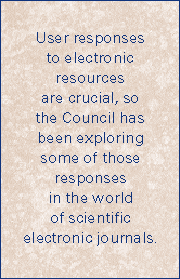
The life cycle of scholarly and scientific communication is the subject of a policy paper commissioned by the Council and being prepared by the Coalition for Networked Information. The project, “Cost Centers and Measures in the Networked Information Value-Chain,” seeks to identify those activities, functions, and departments that will be most affected by the increasing use of networks and networked information. It also will formulate strategies for measuring those impacts over time. The final report and white paper will be distributed in early 1997.
Challenging Marketplace Solutions to Problems
in the Economics of Information
On September 18 and 19, the Council cosponsored a major conference called “Challenging Marketplace Solutions to Problems in the Economics of Information,” held in Washington, DC. Other sponsors included the Association of Research Libraries; the Coalition for Networked Information; the State University of New York at Albany; the University Center Libraries of the State University of New York at Binghamton, Buffalo, and Stony Brook; and the National Association of State Universities and Land-Grant Colleges. The conference brought together academic officers, chief information officers and other administrators, economists, interested faculty, librarians, computing professionals, representatives from higher education associations, and private consultant to examine issues related to the development of the knowledge infrastructure and their economic impact on higher education. The conference proceedings have been published in book form by ARL: Meredith A. Butler and Bruce R. Kingma, eds., The Economics of Information in the Networked Environment (Washington, DC, 1996).
Leadership
Not all libraries are alike, nor are all library leaders. Library leaders come from a variety of backgrounds and possess diverse skills and knowledge. The development of leaders for the future–even more vital in this age of transformation and information revolution–has become a focus of the Council’s efforts. Its program reflects the different leadership needs in the library and information worlds. Now in its second year, the leadership program has covered as broad a base as possible to address the issue of leadership in the profession, for today and for tomorrow.
Kellogg Program
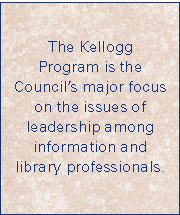
The Council’s activity concentrated on implementing a grant from the W. K. Kellogg Foundation to develop “Human Resources for Information Systems Management” (HRISM). As part of this grant, the Council has created a framework and assessment tool to help the Kellogg Foundation evaluate the many projects and organizations it has supported in its HRISM program. The Council also established a major project to analyze the many different and innovative ways in which public libraries are using technology in their communities.
Under the umbrella of the Kellogg project, leadership has taken on an expanded definition. The Council’s Kellogg project has looked at the following issues:
- how public libraries have become leaders in serving their communities by using new technology,
- how public library leaders have recast the function and purpose of their institutions in their communities, and
- how, in an era of accelerating technical change, leaders of public libraries can be cultivated and trained for the challenges that all libraries will face in the twenty-first century.
The Council, in other words, has defined leadership as something that can be an individual characteristic and an institutional quality. Library directors can be leaders in their libraries; but libraries can also be leaders in their communities. Several projects and activities have grown out of the Council’s Kellogg initiative.
Public Libraries and Innovative Technology
The Council developed case studies of public libraries and their use of technology and then analyzed its findings. At the recommendation of the Council’s Kellogg Program Advisory Committee, the Council’s staff asked libraries to describe how they were serving their communities through technology. From the responses, which came from public libraries in 46 states, the Advisory Committee selected 12 sites to study. Teams from the Council staff visited the sites; talked to directors, library staff, and users; and prepared case studies to describe how these libraries are working in and with their communities in the new era of electronic information. In the process, the Council also learned a great deal about individual leadership styles and the leadership roles that public libraries are assuming in their communities.
Public libraries are continuing to serve important functions in their communities, but the future of these institutions is not assured. Many variables are at work: the uncertainties of funding, the costs of building and maintaining a digital telecommunications infrastructure, the increasing number and variety of information providers within communities, the rapidly changing nature of the technology itself, and the need for training library staffs and the public they serve. One common denominator, however, did emerge: The most vibrant public libraries look to the community at large to determine appropriate goals and objectives, and work with individuals and organizations in the community to carry out the objectives. There are other common components. In each of the 12 cases, these libraries have leadership with vision, common values about open and equitable access to information, funding (in relative terms) to create a new environment using information technologies, and community-centered strategies for making a transition into the increasingly digital information world.
The case studies, when completed, will be made available in printed form and as electronic documents on the Council’s Web site. The Council will continue its Kellogg initiative by focusing efforts on information policy development; professional education curricula; and the infrastructures of technology, information organization, and management. Ultimately the Council hopes to suggest practical frameworks for decision making and the development of library public policy.
Public Library Leaders Summit Meeting
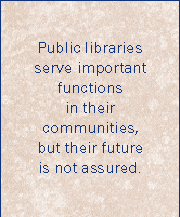
With Kellogg funds, the Council also helped establish an agenda to address the important issues in developing public library leadership for the future. The Council contracted with the University of California, Los Angeles, School of Library and Information Science to hold a summit meeting of public library directors in August 1996 that will suggest how public library leaders should be developed and will frame a preliminary curriculum for the training of future public library directors and information managers.
Libraries and Community Information Networks
In the course of developing public library case studies, the Council teams learned that some communities are building specialized information networks to meet citizens’ needs. In some cases, public libraries and community information networks are working in partnership; in others, they are distinctive entities. Using information gathered during site visits to public libraries, the Council contracted with Northern Lights, Inc., a consulting firm, to develop a framework for understanding the capabilities of systems that bring together information, people, and technologies to support community needs. The framework will be adapted and used as a tool for educating information leaders about how community information networks can enhance the democratic decision-making process by facilitating access to information. The program will feature a series of meetings and the publication of several white papers designed to assist library and information leaders in making decisions about technology and its many uses. It also will encourage closer relationships between libraries and community information networks.
Distance Education in Library and Information Science
In October, the Council convened a meeting of deans from several schools of library and information science to discuss distance education philosophies, the educational options that distance learning affords the profession, and specific training needs to prepare librarians and library leaders for the future. The participants concluded that there is a need for cooperation in the development of specialized programs, for faculty development and expansion, for market analysis and overall assessment of existing programs, and for projects that are financially sustainable.
The Transformation of the Public Library
With the John F. Kennedy School of Government at Harvard University and five other organizations, the Council sponsored a public policy symposium entitled “The Transformation of the Public Library: Access to Digital Information in a Networked World,” held at the Library of Congress on December 8. The conference, which focused on the changing context in which public libraries operate, emphasized the challenges and the opportunities that public libraries face in the information revolution, and the need for striking new partnerships and building alliances.
Preservation
![]()
hether information resides on a cave wall, a thick clay tablet, a dispersed collection of delicate papyrus fragments, a crumbling book, a piece of microfilm, or a file of bytes migrating from one system to another, the central preservation mandate remains: To provide enduring and equitable access to all persons, so that information from the past can contribute to the knowledge base for the future.
Preservation initiatives help libraries, archives, historical societies, and other stewards of our cultural and scholarly heritage maintain usable collections for today’s needs, while building their capability to ensure long-term access to collections in the future. This year, academic and commercial sectors alike have focused on the goal of providing faster access to multiple formats of information to more people. During such times, continued emphasis on collaborative preservation strategies becomes even more essential for the survival of irreplaceable historical resources.
In determining priorities, the Commission and Council build upon earlier projects that addressed paper permanence, large-scale microfilming, cooperative programs, and, most recently, digital reformatting. Activities, however, have involved new partnerships and cooperation from new specialties. The alliance of the Commission and Council enables vital dialogues with economists, leaders of non-profit enterprises, experts in public policy and community development, and professional educators and trainers. Continued focus on preservation goals within this broader set of perspectives bodes well for our combined ability nationally and internationally to serve as the collective guardians of the record of our world’s history and culture.
Advocacy for the NEH Brittle Books Program and Permanent Paper
As has been the custom since 1988, the Commission collaborated with the National Humanities Alliance (NHA) and the Association of Research Libraries (ARL) to provide written testimony in support of annual appropriations for the National Endowment for the Humanities (NEH). In further collaborations with the National Humanities Alliance, the Commission reported on NEH preservation grants for the reformatting of brittle books. The July-August newsletter included a special insert from the NHA concerning the preservation and access activities of NEH.
To educate broader audiences about the plight and treatment of brittle paper, the Library of Congress invited the Commission’s Brittle Books exhibit to be a part of its first Preservation Awareness Day on April 16. Throughout the year, the Commission’s newsletter reported on using permanent paper and the availability of guidelines for permanent papers and environmental storage.
Preservation Science Research Initiative
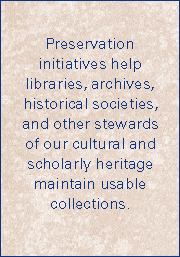
After three years of development and action, the Preservation Science Council (PSC) completed several projects. The PSC is a group of preservation administrators and scientists from 20 university libraries, archives, and laboratories. Convened in 1992, the group participated in a series of Commission-sponsored seminars that resulted in unanimous approval of a preservation research agenda. The agenda’s projects addressed environmental controls and materials science investigations of paper, adhesives, and magnetic media.
This initial agenda was seen as the first successful collaborative effort to identify preservation research needs, reduce them to a practical number, and set priorities for action. In its deliberations, the PSC has emphasized the needs of large, existing collections of libraries and archives and has argued for research designs that lead to useful tools for strategic decision making and cost-effective management.
The Commission has published two of the resulting management tools. One report, Magnetic Tape Storage and Handling: A Guide for Libraries and Archives, was a collaborative effort with the National Media Laboratory. First published in June 1995, this report was reprinted during the year to meet the demand for its distribution at conferences and workshops. The second report, developed by the Image Permanence Institute: New Tools for Preservation: Assessing Long-Term Environmental Effects on Library and Archives Collections, provides libraries and archives with a way to assess and manage the longevity of many different media in collections using a single device and system. The research described was funded by the National Endowment for the Humanities’ Division of Preservation and Access.
PSC members collaborated with other organizations and provided resources for the following activities:
- a research project of the ASTM (American Society for Testing Materials) Institute for Standards Research to determine the role of lignin in longevity of paper;
- an international symposium on videotape preservation priorities funded by the Getty Grant Program, organized by the Bay Area Video Coalition, and hosted by the San Francisco Museum of Modern Art;
- a symposium on the indoor environment, hosted by the New York University Conservation Center, Institute of Fine Arts; and
- the annual preservation conference of the National Archives and Records Administration.
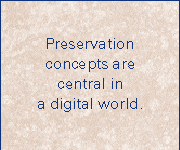 Funding from the William and Flora Hewlett Foundation enabled the PSC to begin building a second research agenda. In light of changing priorities, tight budgets, and divergent opinions about the direction of the preservation field, the PSC expects to set a new course for research that reflects current needs. At a meeting scheduled for August 1996, the PSC will develop top-priority projects selected from several proposals:
Funding from the William and Flora Hewlett Foundation enabled the PSC to begin building a second research agenda. In light of changing priorities, tight budgets, and divergent opinions about the direction of the preservation field, the PSC expects to set a new course for research that reflects current needs. At a meeting scheduled for August 1996, the PSC will develop top-priority projects selected from several proposals:
- how best to lengthen collection life using scientific environmental control schemes
- what can be determined about the life expectancy of modern printing and writing papers
- what life-cycle cost studies could be done on optical and magnetic media
- the extent of the effect of environmental cycling on library and archives collections stored in various ways (encapsulated, compact shelving, boxed)
Preservation Management and Technology
As digital technologies provide new ways to reformat and gain access to the collections of libraries and archives, it is important to establish an intellectual rationale for the centrality of preservation concepts and ethics. One of the most requested reports was Preservation in the Digital World, which suggests that many of the basic tenets of preservation management can be applied in a highly technological environment, but that some long-held principles may no longer apply. The publication urged that preservation planning, management, and action be carried out at the highest level, since information in digital form is far more fragile than the clay and papyrus that have survived through centuries.
Some of the technology reports helped institutions understand how new digital reformatting techniques can and should be applied to preservation needs. The preservation concerns associated with digitizing brittle maps for scholarly use were addressed in Oversize Color Images Project,. This report described an investigation at Columbia University to learn how scanning could provide acceptable digital surrogates for scholarly use so that re-scanning would not be needed in the future. The preservation concerns of digitizing fragile papyrus collections from many locations for research and study was the subject of another report, Digital Imaging of Papyri.
Scholarly Involvement
At the conclusion of an 18-month project funded by the H. W. Wilson and Gladys Krieble Delmas Foundations, the Commission issued a report that makes specific recommendations for future scholarly involvement based on a review of the seven-year Scholarly Advisory Program. Difficult Choices: How Can Scholars Help Save Endangered Research Resources? makes the case that scholars must be involved in the selection of materials to be scanned and that working with scholarly organizations would be most productive. The Council and Commission, in cooperation with the American Council of Learned Societies, are exploring ways to bring scholars more fully into the preservation agenda, both individually and as members of disciplinary societies.
The first group to be formed following the recommendations of the above report was a Scholarly Task Force on Hispanic Literary Heritage, charged with articulating a strategy for identifying and preserving Hispanic materials in the United States. The task force, which includes a number of individuals from the Recovering the U.S. Hispanic Literary Heritage Project at the University of Houston, will prepare a written report to be distributed widely.
To provide additional perspectives about digitizing visual collections, the Commission published an abbreviated version of an article by a professor of art history, Computer Images for Research, Teaching, and Publication in Art History and Related Disciplines. In addition to raising issues of quality and longevity of access, Charles Rhyne’s article makes a strong case for the involvement of scholars in influencing the directions of digital imaging projects.
The International Program
From its beginnings, the Commission recognized that U.S. scholars and researchers need access to library and archival materials stored in all parts of the world. Yet, it also recognized that many regions with substantial intellectual treasures did not have sufficient preservation techniques or resources to ensure enduring access to these materials. The Commission established the International Program to promote preservation awareness throughout the globe and to establish collaborative projects that would improve the accessibility of research materials to scholars everywhere.
Remembering its role as a catalytic organization, the Commission has concentrated its international efforts on identifying countries, regions, and groups that are willing and able to undertake preservation and access projects. During the past year, in many countries, especially developing nations, concerns about acidic paper were overshadowed by immediate threats of heat, humidity, pests, lack of proper storage conditions, and deterioration of other materials–including such basic media as palm leaves. In many cases, digitization was viewed as a solution to most if not all of these problems, a notion perhaps encouraged by easier availability of funds for technological solutions. However, this expectation, in many cases, was found to lead to neglect of solid, proven, and low-technology preservation methods.
For many institutions in developing nations, large-scale digital approaches to preservation and access are still several years away. In several instances, project planners have decided that basic procedures to arrest the deterioration of collections and holdings–heat and humidity controls, proper storage environments, security, pest control, and deacidification–need to go hand in hand with explorations of digital solutions. Within that context, the International Program has emphasized training and education, sharing not only the developments in the digital age, but also addressing the day-to-day difficulties of preserving and providing access to endangered materials.
With its worldwide perspective, the International Program must necessarily maintain a steady, yet flexible, presence in order to monitor activities, build communication channels, develop projects, and provide intellectual stimulus and seed funding for catalytic activities. During 1994-1995, the Commission worked with a number of organizations, both new and old, to strengthen preservation and access programs and to develop mechanisms that help us share our scholarly and cultural resources around the globe.
Shared Bibliographic Records of Preserved Materials
 Since 1990, the Commission has collaborated, initially with the Commission of the European Union (CEU), then directly with the institutions involved, to create the European Register of Microform Masters (EROMM). EROMM has become a model of multinational cooperation among libraries and archives. In addition to the four original partners (national libraries of France, Portugal, England, and the Staats- und Universitatsbibliothek Gottingen), the following have joined EROMM: the national libraries of Denmark, The Netherlands, and Belgium; the ETH Library Zurich; and Deutsches Bibliotheksinstitut, Berlin. In addition, the national libraries of Poland, Hungary, Austria, and Sweden expect to join this effort. At present, 34 institutions in seven countries have contributed to the database of more than 325,000 items. Under a Commission contract with EROMM, this register was made available for distribution through the U.S. bibliographic utilities. Although the Commission’s financial support ended in December, collaboration continues with EROMM’s Management Committee.
Since 1990, the Commission has collaborated, initially with the Commission of the European Union (CEU), then directly with the institutions involved, to create the European Register of Microform Masters (EROMM). EROMM has become a model of multinational cooperation among libraries and archives. In addition to the four original partners (national libraries of France, Portugal, England, and the Staats- und Universitatsbibliothek Gottingen), the following have joined EROMM: the national libraries of Denmark, The Netherlands, and Belgium; the ETH Library Zurich; and Deutsches Bibliotheksinstitut, Berlin. In addition, the national libraries of Poland, Hungary, Austria, and Sweden expect to join this effort. At present, 34 institutions in seven countries have contributed to the database of more than 325,000 items. Under a Commission contract with EROMM, this register was made available for distribution through the U.S. bibliographic utilities. Although the Commission’s financial support ended in December, collaboration continues with EROMM’s Management Committee.
The Commission supported the development of a Latin American Register of Microform Masters with a project titled “Infrastructure for automated processing of microform holdings in Latin America and the Caribbean.” In this collaborative effort, the National Library of Venezuela has assembled more than 15,000 bibliographic descriptions of microform holdings in 11 Venezuelan institutions. In Phase II, microform records from Costa Rica, Brazil, Portugal, Argentina, and Cuba are expected to be added to the register which will, like EROMM, be shared with the U.S. scholarly and library communities.
Another project is converting to machine-readable, U.S.-compatible format bibliographic records of microform masters held by libraries and archives in Poland. This Commission-supported effort will enable Poland to join EROMM and offer assistance to similar projects in other countries of Central and Eastern Europe.
Collaboration and Advocacy
Contributions to large-scale global organizations provide an important avenue for the Commission to leverage the effects of its international capacity. The Commission continued its involvement with UNESCO’s “Memory of the World” initiative to save our common cultural heritage and, in addition, worked with UNESCO to plan a new edition of its “General Guidelines to Safeguard Documentary Heritage.” Near the close of the year, the International Program established closer ties with IFLA (International Federation of Library Associations and Institutions), and in particular with its core program, PAC (Preservation and Conservation).
In another type of collaboration, several Commission Board members met with their counterparts at the first public meeting of the European Commission on Preservation and Access (ECPA) to discuss how the two organizations could work together to advance the preservation agenda. Reflecting a shared interest in preservation research questions, the two organizations agreed to co-publish a joint scientific report on mass deacidification in the fall of 1996.
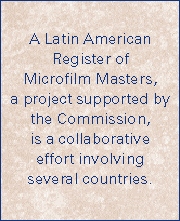 Other collaborations focused on technical issues. Directorate XIII (Library Networks and Services) of the Commission of the European Union invited the Task Force on Archiving of Digital Information to share its conclusions with a European group working on similar issues. The meeting in Luxembourg in December was recognized as an important first step toward collaboration on a truly global issue. In another technology initiative, the Commission participated in discussions with the Archives of Seville for the establishment of a mirror-site in the U.S. This project will make a substantial set of the archives’ digitized documents accessible to U.S. scholars. The Bancroft Library at the University of California, Berkeley, also is cooperating.
Other collaborations focused on technical issues. Directorate XIII (Library Networks and Services) of the Commission of the European Union invited the Task Force on Archiving of Digital Information to share its conclusions with a European group working on similar issues. The meeting in Luxembourg in December was recognized as an important first step toward collaboration on a truly global issue. In another technology initiative, the Commission participated in discussions with the Archives of Seville for the establishment of a mirror-site in the U.S. This project will make a substantial set of the archives’ digitized documents accessible to U.S. scholars. The Bancroft Library at the University of California, Berkeley, also is cooperating.
Finally, the Commission assumed responsibility for an ongoing microfilming project at Fudan University in Shanghai. The project will microfilm and make available in the U.S. more than 4,000 titles of Chinese-language monographs published during Japan’s occupation of China and the Sino-Japanese War (1932-1945). The project was initiated by the Committee on Scholarly Communication with China, which closed its office in June.
Education and Training
In many countries, library and archives leaders continued to cite the need for preservation education and training. In its “General Guidelines to Safeguard Documentary Heritage,” UNESCO pointed out that language differences present barriers to the provision of professional preservation training. Much material available on the Internet is in English, and a significant part of the preservation literature is published only in English.
Responding to this need, The Andrew W. Mellon Foundation funded a project “Publication and Dissemination of Preservation Knowledge in Brazil,” with the Commission acting as U.S. coordinator. Phase I involved the selection and translation into Portuguese of more than 1,000 pages of current literature covering the entire spectrum of preservation and conservation. In Phase II, this literature will be distributed to almost 1,500 libraries and archives in Brazil. The literature will support week-long workshops in five regions, where 70 participants will be trained in preservation and conservation concepts.
A significant aspect of this project is the creation of a common database of information about the status of collections and efforts to preserve them. The overall guidance for the project was provided by an alliance of more than 15 organizations with an interest in preservation. At an April meeting in Rio de Janeiro, representatives of the alliance’s organizations pledged full collaboration. A similar project, “Program for Translating Preservation Literature into Spanish,” was proposed by the National Library of Venezuela and ABINIA, the Association of National Libraries of Iberoamerica. Discussions of conceptual and organizational issues are under way.
Communications and Publications
![]() ommunications and publications of the Commission and Council inform, advocate, and facilitate action in support of the organizations’ programs. Today, many types of institutions are providing access to information. Reports, newsletters, press releases, and brochures of CLR and CPA help orient and inform these institutions about the unique strengths and roles of libraries and archives. Other reports provide scientific and technical knowledge necessary for effective management in an increasingly digital and commercial world of information access. By broadly communicating what is learned in research-and-demonstration projects, the Commission and Council bring the lessons of their programs and initiatives to the widest possible audience.
ommunications and publications of the Commission and Council inform, advocate, and facilitate action in support of the organizations’ programs. Today, many types of institutions are providing access to information. Reports, newsletters, press releases, and brochures of CLR and CPA help orient and inform these institutions about the unique strengths and roles of libraries and archives. Other reports provide scientific and technical knowledge necessary for effective management in an increasingly digital and commercial world of information access. By broadly communicating what is learned in research-and-demonstration projects, the Commission and Council bring the lessons of their programs and initiatives to the widest possible audience.
Displays, Newsletters, and Publications
Displays, exhibits, and presentations at scholars’ conferences, librarians’ workshops, regional meetings, and national and international conventions provided basic information to new audiences. As one result of these events, over 200 new scholars and faculty requested that they receive Commission newsletters and publications on a regular basis. The monthly newsletter, reporting on Commission and Council activities, was distributed to a closely managed list of 2,000 librarians, archivists, scholars, university and college administrators, publishers, regional and state agencies, museums, and other interested organizations and individuals in the U.S. and abroad.
Reports (listed in the appendix) dealt with technical, scholarly, and preservation science issues. During their preparation, primary constituencies in each area helped identify the most important management questions. The Commission and Council then engaged recognized experts to explain issues in the language of generalists. Funding from The Andrew W. Mellon Foundation assured that complimentary copies of reports were distributed to a broad constituency. In addition, the Commission and Council filled more than 15,000 paid orders.
The first joint publication of the Commission and Council, Digital Collections Inventory Report, described a preliminary project undertaken by the two organizations to determine the extent of digitizing of library collections to date. The report also explores ways to keep informed about what is available on the Internet and how to inventory what will be added by libraries in the future.
Council Statement on Fair Use
In February, the Council issued a Statement on the Fair Use Doctrine emphasizing the centrality of the fair use doctrine to the development and dissemination of scholarship in the United States. The statement, a response to proposed revisions of the Copyright Law, expresses the concern of the Council’s Board of Directors for continued access and the free flow of information in the new era of electronic communication. It also argues that the current principle in copyright law that allows libraries to reproduce and distribute copies for preservation purposes should be retained in an electronic environment.
World Wide Web
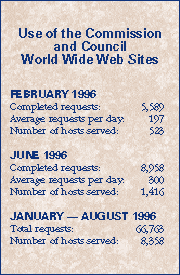 World Wide Web home pages, developed in collaboration with Stanford University Libraries, served as new access points for information about the Commission and Council. Made public in January, the home pages introduce basic programs and provide links to related projects and activities. The later addition of newsletters and publications substantially increased the number of queries to the sites in the closing months of the year. Stanford’s collaborative work provided keyword searching of the online documents, direct e-mail contact back to staff, and an increasing number of links to other Web sites.
World Wide Web home pages, developed in collaboration with Stanford University Libraries, served as new access points for information about the Commission and Council. Made public in January, the home pages introduce basic programs and provide links to related projects and activities. The later addition of newsletters and publications substantially increased the number of queries to the sites in the closing months of the year. Stanford’s collaborative work provided keyword searching of the online documents, direct e-mail contact back to staff, and an increasing number of links to other Web sites.
Film
The production of a major documentary on the management and preservation of information in the electronic age started in May, supported by the National Endowment for the Humanities, the Xerox Corporation, and the Alfred P. Sloan Foundation. The production, to be issued as a one-hour broadcast film and 30-minute video, will examine the ephemeral nature of digital materials and will call for renewed preservation measures in the electronic environment to assure continuing access to scholarly materials. The documentary is a joint project with the American Council of Learned Societies. Teaching and study resources will be developed to accompany the film, and its distribution will be subsidized. Multi-language translations of the program will be available for use around the world.
Collaborations
College Libraries Committee (CLC)
![]() he Commission established the College Libraries Committee in February 1989 to consider the role of college libraries in the national preservation agenda. The committee, composed of college library directors, sponsors a regular library journal column about preservation and has developed a preservation management training institute offered at various locations over the past several years. In July, a seminar in Santa Fe, NM, cosponsored by AMIGOS Bibliographic Council, included the topic of digitization systems for preservation and access, along with more long-term concerns of program management, selection, and environmental control.
he Commission established the College Libraries Committee in February 1989 to consider the role of college libraries in the national preservation agenda. The committee, composed of college library directors, sponsors a regular library journal column about preservation and has developed a preservation management training institute offered at various locations over the past several years. In July, a seminar in Santa Fe, NM, cosponsored by AMIGOS Bibliographic Council, included the topic of digitization systems for preservation and access, along with more long-term concerns of program management, selection, and environmental control.
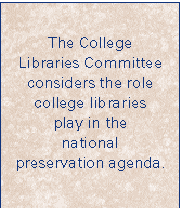 To determine the current state of preservation activities in college libraries and to assist in program development, the College Libraries Committee surveyed 200 colleges about preservation priorities, funding, staffing, collection assessment, environmental conditions, and institutional preservation needs and concerns. Over half of the surveyed institutions responded. Among the results:
To determine the current state of preservation activities in college libraries and to assist in program development, the College Libraries Committee surveyed 200 colleges about preservation priorities, funding, staffing, collection assessment, environmental conditions, and institutional preservation needs and concerns. Over half of the surveyed institutions responded. Among the results:
- Sixty percent of the libraries reported that between one and four percent of their budget allocation is for preservation-related activities;
- Surveyed libraries devote an average of .52 FTE staff to preservation;
- Three-quarters of those surveyed have enrolled one or more staff members in preservation training programs outside the library;
- Over one-third of the respondents indicate that preservation is a higher priority than it was five years ago.
The raw results were made available on the Commission’s Web site and reported in the Commission’s newsletter. Committee members are preparing a more in-depth analysis of the results for publication in late 1996.
After identifying scanning for preservation and access as a primary interest of their colleagues, the committee sponsored a workshop titled “Digitizing Texts and Images: A Workshop for College Library Directors” in Charleston, SC, in April. Speakers addressed the needs of college library directors who wanted to know more about digitization and who are considering digitization projects. The program, attended by nearly 100 individuals, included presentations on digital image quality during conversion projects; preservation in a digital world; lessons learned from digitizing one million pages; and the standards, training, costs, and uses of electronic texts and images on the Internet. Abstracts of the talks were made available on the Commission’s Web site.
Preservation Managers Council
The Preservation Managers Council provides a forum for administrators of large preservation programs and serves as a communication link between the Commission and preservation professionals. The PMC has helped carry forward the work of the Preservation Science Research initiative and has assisted with technical research projects.
At a meeting in September, members of the PMC reviewed their four-year history and identified the issues of greatest interest: selection for preservation and digitization, standards, advocacy in a time of change, reinvention of the preservation profession, and education.
